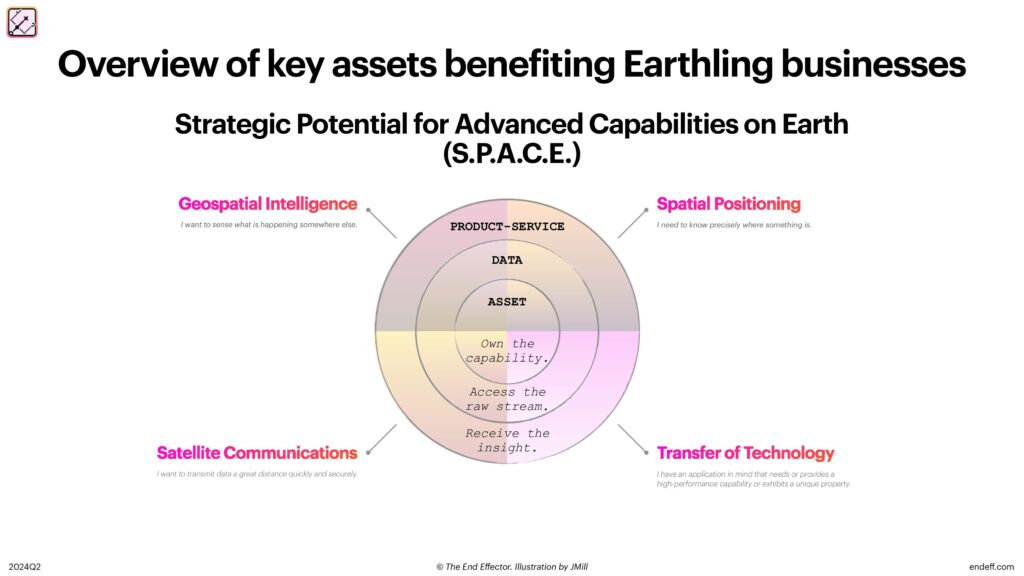How to think about new Space capabilities
by JMill. March 15, 2024 | Space for Earthlings 🌏🛰️

In years past, a Space-curious organization would expect to build most of its own capabilities, literally assembling the nuts and bolts of satellites, securing a spot on a rocket a couple years in advance, and handling all manner of other collateral work to get stuff into Space and to then retrieve data or objects from Space. This is incredibly expensive – at least several hundreds of millions of dollars. But that is no longer the situation.
For an organization to develop a Space capability, there are launch services such as SpaceX which provides the “cargo ship” that accommodates “shipping containers,” satellite platforms such as Rocket Labs’s Photon satellite bus with standard components such as solar panels, battery, primary radio, and other balance-of-plant. This is a recent phenomenon developed over the past decade that now enables Space-curious organizations to focus on their unique area of value creation, such as Varda’s pharmaceutical factory and reëntry pod. [1] SpaceX has built a business platform upon which other businesses (including startups and new-to-Space companies) can develop new product-services.
Since most organizations no longer need to control the majority of their own Space equipment, executives can look at what new Space-based capabilities are coming online, and which others are becoming available at lower cost and higher fidelity. Prepared below is a capabilities chart to aid Earthlings. We call it the S.P.A.C.E chart (Strategic Potential for Advanced Capabilities on Earth).
From a ‘zoomed-out’ view, the main terrestrially-relevant areas of Space capabilities can be broadly bucketed as follows:
- Geospatial Intelligence: I want to sense what is happening somewhere else.
- Communications: I want to transmit data a great distance quickly and securely.
- Spatial Positioning: I need to know precisely where something is and when it is there.
- Transfer of Technology: I have an application in mind that needs or provides a high-performance capability or exhibits a unique property.
There are concentric rings across each set of capabilities to delineate the level of Space knowledge and organizational commitment necessary to extract value from any particular capability. The levels are:
- Product-Service: receiving decision-making information derived from Space assets.
- Data: Accessing raw data from Space that needs further processing by machines (and occasionally by Earthlings) before it is useful for a business.
- Asset: Owning, operating, and/or otherwise controlling an instrument, sensor, or other form of Space-based tool or system.
Below is a deeper look at the buckets of Geospatial Intelligence, Communications, Spatial Positioning, and Transfer of Technology, followed by an elaboration of the levels of capability (Product-Services, Data, and Asset) that applies to all buckets.
- Geospatial Intelligence (GeoInt) encompasses the means for imaging, scanning, and sensing of phenomena above, on, and below the Earth’s surface. Such instrumentation can be as specific as counting cars in a parking lot, identifying the presence of ancient buried ruins, or broader uses such as tracking the layers of a weather system that could develop into a hurricane. If you ever used Google Earth or the Satellite view in an app that gives driving directions, you were using GeoInt-derived data. The infrastructure necessary to enable GeoInt include imaging satellites, machine vision computing resources, and data downlink between a satellite and a ground station. Some common units of measure include the data’s resolution, which is often in square-meters (m^2), expanse as per square-kilometer, but at the Product-Service level there can be a variety of ways a business may engage, such as dollars-per-square-kilometer or cost-per-“insight”.
- Communications (Comms) is focused on how data is transferred as x-to-sat, sat-to-x, and sat-to-sat. This has to do with the uplink and downlink between an orbiting satellite or vehicle and a ground station located somewhere on Earth. For example, SpaceX Starlink is projected to have tens of thousands of orbiting smallsats, dozens or hundreds of ground stations on the surface, and thousands of end-user terminals (with consumer-friendly names like Dishy McFlatface). With mathematical choreography, they are able to send data bidirectionally between ground stations and terminals by relaying across whichever satellites happen to be passing overhead at the time of data transmission. Units of measure of satellite communications tends to be assessed similarly as terrestrial broadband measurements, such as gigabits or terabits per second. Satellite communications can occur via a variety of physical phenomena, such as radio frequency or optical (usually laser) means.
- Spatial Positioning (SPS) is for locating where things are, whether physical objects and entities or abstractions such as political borders. Underlying infrastructure include the Global Positioning System (GPS), a U.S.-origin service [2] comprising a constellation of satellites to emit radio frequencies at specific timed intervals that are detectable and interpretable by a GPS receiver, such as a mobile device, including most modern phones. Working in conjunction with terrestrial cellular towers, Wi-Fi nodes, and other telecommunications equipment, GPS is what allows a ‘you are here’ dot to appear on a map when you use an iPhone to get walking directions toward the nearest grocery store. With emerging applications in augmented reality, Spatial Positioning is becoming a crucial component of businesses. Historical applications are varied, including the use of detailed mapping that urban planners and self-driving vehicles are relying upon. The global hide-and-seek game Geocaching, as well as Niantic’s Pokemon Go, are consumer-grade examples of Spatial Positioning infrastructure being profitably leveraged for enjoyment by Earthlings.
video: Geo-located by the green dot. Screenshot by JMill with iOS. Animation by JMill.
- Transfer of Technology (ToT) is the development of new capabilities in one field that are then able to be refined and deployed in a different field or domain. This is often an endeavor reserved for organizations with R&D capabilities, to be able to effectively utilize technologies that were originally developed with Space in mind, but which may advance terrestrial capabilities in some way. The predominant ToT work occurs in the realm of atoms-based concerns, such as novel materials, lower friction mechanisms, new forms of automation, and greater tenability. For example, velcro straps were originally developed for securing objects to each other in low-gravity environments, but found utility for securing shoes to an Earthling child’s feet, among many other applications. There are also ToT opportunities in the digital realm, such as in the discovery and deployment of improved command and control architectures, data compression, and signal processing and error correction, to name a few areas. Companies developing undersea applications may benefit from Space technologies and vice-versa, particularly for GPS-denied navigation and autonomous decision making.
For deeper dives on several elements within the buckets of Geospatial Intelligence, Spatial Positioning, and Communications, check out Space Capital’s playbooks and companion resources for great starting points.
As the SPACE chart introduced earlier shows, there are multiple levels of organizational commitment that underpin the buckets of GeoInt, Comms, SPS, and ToT. These are Product-Service, Data, and Asset, elaborated as follows:
- Product-Service provide customers with insights, often information that its suitable for decision-making. For example, an industrial agricultural customer may pay for a map showing where particular soils are under-utilized and what to do about it. The purchase of Product-Services is the simplest point of engagement for Earthling businesses. Space-based Product-Service providers are proliferating as orbital capabilities improve and as traditional enterprises and markets become attuned to Space offerings.
- Data provides customers with a raw or lightly-cleaned stream of images, signals, blips and bloops, upon which the customer must have the means to further process the data into something more useful to the business. Carrying on the example introduced above of the agricultural customer, this would be as if the customer is receiving hyper-spectral times-series images and assessing them manually or, for more sophisticated customers, using the images as input into a proprietary vision computing tool. Consuming raw data streams is not common among most Earthling businesses due to the collateral needs for expertise, computing, and other resources to conduct effective data analysis, but it can provide a competitive advantage for prepared organizations.
- Asset provides customers with the ‘closest to the metal’ experience, involving some form of direct control and/or responsibility toward Space-based hardware, like an imaging satellite. For our agricultural customer, this is akin to making a big commitment on the organization and its reliance on Space, such as by partnering with a satellite architect like Airbus Space and Defense to design and eventually operate a satellite (or at least a payload), strategize on orbiting needs, securing launch plans, planning end-of-life, etc. This is not for the faint of heart, as it is typically more expensive in the short and medium term compared to securing Data-level or Product-Service-level access. However, developing an Asset can be a strategic boon if done well. John Deere, best known for its agricultural equipment, has secured Asset-level access to Space, which may enable the company to develop new Product-Services. In a partnership with SpaceX, the company is connecting its equipment to high-speed Internet, an infrastructure play that reinforces the importance of the Agriculture industry to the Space industry, and vice-versa. See this Wall Street Journal article for more about the partnership.
The SPACE chart is intended to simplify – without dumbing down – several of the major areas where Space infrastructure will influence organizations. Some influence may be subtle, an astronomer’s society witnessing a string of smallsats heading toward their destination orbits.
Others are more pronounced, such as how we tend to rely on Uber to ferry us via optimal route to a new restaurant on the other side of town that we saw pop up on Yelp – both Uber, Yelp, and thousands of other companies couldn’t have emerged without Space-based assets quietly operating behind the scenes. You may be surprised at the sheer number of employees – perhaps a third or greater – at these companies whose jobs are focused on improving geospatial accuracy to improve user experience and business outcomes.
𝝭
[1] The analogies above are based on a conversation between Delian Asparouhov and Jason Calacanis on This Week in Startups episode 1793.
[2] There are efforts among other nations to build GPS-equivalent systems as a priority for national sovereignty.
video: Geo-located by the green dot. Screenshot by JMill with iOS. Animation by JMill.
⃪ View “What is going on up there?”
(previous article)
View “Space for Earth and Earth for Space” →
(next article)
“…but deep down, don’t you feel it, too? ‘Maybe someday’ is just today waiting for a nudge.”
Net proceeds from The End Effector are given to foundations, initiatives, and charities advancing interdisciplinary sciences.


